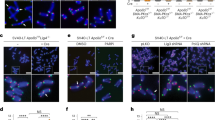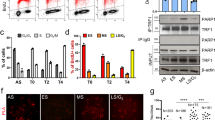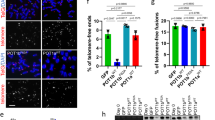Abstract
In most eukaryotes, poly(ADP-ribose) polymerase (PARP) recognizes DNA strand interruptions generated in vivo. DNA binding by PARP triggers primarily its own modification by the sequential addition of ADP-ribose units to form polymers; this modification, in turn, causes the release of PARP from DNA ends1. Studies on the effects of the disruption of the gene encoding PARP (Adprt1, formerly Adprp) in mice have demonstrated roles for PARP in recovery from DNA damage and in suppressing recombination processes involving DNA ends1,2,3,4,5. Telomeres are the natural termini of chromosomes and are, therefore, potential targets of PARP. Here, by the use of two different techniques, we show that mice lacking PARP display telomere shortening compared with wild-type mice. Telomere shortening is seen in different genetic backgrounds and in different tissues, both from embryos and adult mice. In vitro telomerase activity, however, is not altered in Adprt1–/– mouse fibroblasts. Furthermore, cytogenetic analysis of mouse embryonic fibroblasts reveals that lack of PARP is associated with severe chromosomal instability, characterized by increased frequencies of chromosome fusions and aneuploidy. The absence of PARP does not affect the presence of single-strand overhangs, naturally present at the ends of telomeres. This study therefore reveals an unanticipated role for PARP in telomere length regulation and provides insights into its functions in maintaining genomic integrity.
This is a preview of subscription content, access via your institution
Access options
Subscribe to this journal
Receive 12 print issues and online access
$209.00 per year
only $17.42 per issue
Buy this article
- Purchase on Springer Link
- Instant access to full article PDF
Prices may be subject to local taxes which are calculated during checkout



Similar content being viewed by others
References
Lindahl, T., Satoh, M.S., Poirier, G.G. & Klungland, A. Post-translational modification of poly(ADP-ribose) polymerase induced by DNA strand breaks. Trends Biochem. Sci. 20, 405–411 (1995).
Jeggo, P.A. DNA repair: PARP–another guardian angel? Curr. Biol. 8, R49–51 (1998).
Wang, Z.Q. et al. PARP is important for genomic stability but dispensable in apoptosis. Genes. Dev. 11, 234723–234758 (1997).
de Murcia, J.M. et al. Requirement of poly(ADP-ribose) polymerase in recovery from DNA damage in mice and in cells. Proc. Natl Acad. Sci. USA 94, 7303–7307 (1997).
Morrison, C. et al. Genetic interaction between PARP and DNA-PK in V(D)J recombination and tumorigenesis. Nature Genet. 17, 479–482 (1997).
Wang, Z.Q. et al. Mice lacking ADPRT and poly(ADP-ribosyl)ation develop normally but are susceptible to skin disease. Genes Dev. 9, 509–520 (1995).
Zijlmans, J.M. et al. Telomeres in the mouse have large inter-chromosomal variations in the number of T2AG3 repeats. Proc. Natl Acad. Sci. USA 94, 7423–7428 (1997).
Blasco, M.A. et al. Telomere shortening and tumor formation by mouse cells lacking telomerase RNA. Cell 91, 25–34 (1997).
Lee, H.W. et al. Essential role of mouse telomerase in highly proliferative organs. Nature 392, 569–574 (1998).
Herrera, E. et al. Disease states associated with telomerase deficiency appear earlier in mice with short telomeres. EMBO J. 18, 2950–2960 (1999).
Rufer, N., Dragowska, W., Thornbury, G., Roosnek, E. & Lansdorp, P.M. Telomere length dynamics in human lymphocyte subpopulations measured by flow cytometry. Nature Biotechnol. 16, 743–747 (1998).
McClintock, B. The stability of broken ends of chromosomes in Zea mays. Genetics 25, 234–282 (1941).
Riboni, R. et al. Telomeric fusions in cultured human fibroblasts as a source of genomic instability. Cancer Genet. Cytogenet. 95, 130–136 (1997).
van Steensel, B., Smogorzewska, A. & de Lange, T. TRF2 protects human telomeres from end-to-end fusions. Cell 92, 401–413 (1998).
Lindahl, T., Barnes, D.E., Klungland, A., Mackenney, V.J. & Schar, P. Repair and processing events at DNA ends. Ciba Found. Symp. 211, 198–205 (1997).
Poirier, G.G., de Murcia, G., Jongstra-Bilen, J., Niedergang, C. & Mandel, P. Poly(ADP-ribosyl)ation of polynucleosomes causes relaxation of chromatin structure. Proc. Natl Acad. Sci. USA 79, 3423–3427 (1982).
Ding, R., Pommier, Y., Kang, V.H. & Smulson, M. Depletion of poly(ADP-ribose) polymerase by antisense RNA expression results in a delay in DNA strand break rejoining. J. Biol. Chem. 267, 12804–12812 (1992).
Murnane, J.P., Sabatier, L., Marder, B.A. & Morgan, W.F. Telomere dynamics in an immortal human cell line. EMBO J. 13, 4953–4962 (1994).
McEachern, M.J. & Blackburn, E.H. Cap-prevented recombination between terminal telomeric repeat arrays (telomere CPR) maintains telomeres in Kluyveromyces lactis lacking telomerase. Genes Dev. 10, 1822–1834 (1996).
Bryan, T.M., Englezou, A., Gupta, J., Bacchetti, S. & Reddel, R.R. Telomere elongation in immortal human cells without detectable telomerase activity. EMBO J. 14, 4240–4248 (1995).
Smith, S., Giriat, I., Schmitt, A. & de Lange, T. Tankyrase, a poly(ADP-ribose) polymerase at human telomeres. Science 282, 1484–1487 (1998).
Rudolph, K.L. et al. Longevity, stress response, and cancer in aging telomerase-deficient mice. Cell 96, 701-712 (1999).
Cristovao, L. et al. Absence of stimulation of poly(ADP-ribose) polymerase activity in patients predisposed to colon cancer. Br. J. Cancer 77, 1628–1632 (1998).
Henderson, L.O., Marti, G.E., Gaigalas, A., Hannon, W.H. & Vogt, R.F. Jr Terminology and nomenclature for standardization in quantitative fluorescence cytometry. Cytometry 33, 97–105 (1998).
Kipling, D. & Cooke, H.J. Hypervariable ultra-long telomeres in mice. Nature 347, 400–402 (1990).
Dionne, I. & Wellinger, R.J. Cell cycle-regulated generation of single-stranded G-rich DNA in the absence of telomerase. Proc. Natl Acad. Sci. USA 93, 13902–13907 (1996).
Kim, N.W. et al. Specific association of human telomerase activity with immortal cells and cancer. Science 266, 2011–2015 (1994).
Wright, W.E., Shay, J.W. & Piatyszek, M.A. Modifications of a telomeric repeat amplification protocol (TRAP) result in increased reliability, linearity and sensitivity. Nucleic Acids Res. 23, 3794–3795 (1995).
Acknowledgements
We thank members of the Jackson lab, in particular D. D'Amours, for helpful discussions; A. Venkitaraman for advice; M. Hemann in C. Greider's lab for advice on the single-strand detection technique; and T. de Lange for the pTH5 plasmid. F.d.'A.d.F. is supported by The Cancer Research Campaign Project grant SP2143/0301. Work by M.P.H. and P.M.L. was supported by a grant from the National Cancer Institute of Canada with funds from the Terry Fox Run. W.-M.T. and Z.-Q.W. are supported by a grant from the Association for International Cancer Research.
Author information
Authors and Affiliations
Corresponding author
Rights and permissions
About this article
Cite this article
Fagagna, F., Hande, M., Tong, WM. et al. Functions of poly(ADP-ribose) polymerase in controlling telomere length and chromosomal stability. Nat Genet 23, 76–80 (1999). https://doi.org/10.1038/12680
Received:
Accepted:
Issue Date:
DOI: https://doi.org/10.1038/12680
This article is cited by
-
Functions of ADP-ribose transferases in the maintenance of telomere integrity
Cellular and Molecular Life Sciences (2022)
-
MYC: a multipurpose oncogene with prognostic and therapeutic implications in blood malignancies
Journal of Hematology & Oncology (2021)
-
The capacity of oocytes for DNA repair
Cellular and Molecular Life Sciences (2018)
-
Characterization of the 5′-flanking region of the human DNA helicase B (HELB) gene and its response to trans-Resveratrol
Scientific Reports (2016)
-
Structural Requirements of Some 2-(1-Propylpiperidin-4-yl)-1H-benzimidazole-4-carboxamide Derivatives as Poly (ADP-Ribose) Polymerase (PARP) for the Treatment of Cancer: QSAR Approach
Interdisciplinary Sciences: Computational Life Sciences (2016)



